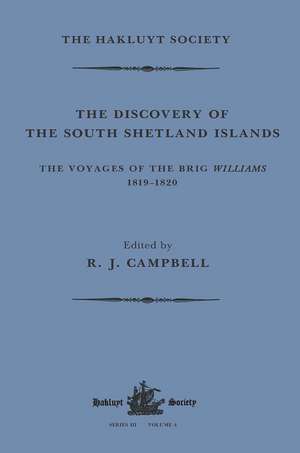The Discovery of the South Shetland Islands / The Voyage of the Brig Williams, 1819-1820 and The Journal of Midshipman C.W. Poynter: Hakluyt Society, Third Series
Editat de R. J. Campbellen Limba Engleză Paperback – 29 apr 2022
Din seria Hakluyt Society, Third Series
- 9%
 Preț: 869.49 lei
Preț: 869.49 lei -
 Preț: 312.51 lei
Preț: 312.51 lei -
 Preț: 312.09 lei
Preț: 312.09 lei -
 Preț: 297.53 lei
Preț: 297.53 lei - 9%
 Preț: 937.13 lei
Preț: 937.13 lei -
 Preț: 311.41 lei
Preț: 311.41 lei - 9%
 Preț: 942.92 lei
Preț: 942.92 lei -
 Preț: 324.57 lei
Preț: 324.57 lei -
 Preț: 311.80 lei
Preț: 311.80 lei -
 Preț: 312.86 lei
Preț: 312.86 lei -
 Preț: 324.37 lei
Preț: 324.37 lei -
 Preț: 313.67 lei
Preț: 313.67 lei -
 Preț: 314.06 lei
Preț: 314.06 lei -
 Preț: 299.73 lei
Preț: 299.73 lei -
 Preț: 312.09 lei
Preț: 312.09 lei -
 Preț: 317.78 lei
Preț: 317.78 lei -
 Preț: 316.29 lei
Preț: 316.29 lei -
 Preț: 315.29 lei
Preț: 315.29 lei -
 Preț: 316.87 lei
Preț: 316.87 lei -
 Preț: 309.70 lei
Preț: 309.70 lei -
 Preț: 312.61 lei
Preț: 312.61 lei
Preț: 311.47 lei
Nou
Puncte Express: 467
Preț estimativ în valută:
59.61€ • 62.07$ • 50.38£
59.61€ • 62.07$ • 50.38£
Carte disponibilă
Livrare economică 14-28 februarie
Livrare express 31 ianuarie-06 februarie pentru 32.84 lei
Preluare comenzi: 021 569.72.76
Specificații
ISBN-13: 9781032319452
ISBN-10: 1032319453
Pagini: 248
Dimensiuni: 174 x 246 x 17 mm
Greutate: 0.46 kg
Ediția:1
Editura: Taylor & Francis
Colecția Routledge
Seria Hakluyt Society, Third Series
Locul publicării:Oxford, United Kingdom
ISBN-10: 1032319453
Pagini: 248
Dimensiuni: 174 x 246 x 17 mm
Greutate: 0.46 kg
Ediția:1
Editura: Taylor & Francis
Colecția Routledge
Seria Hakluyt Society, Third Series
Locul publicării:Oxford, United Kingdom
Cuprins
The Discovery of the South Shetland Islands / The Voyage of the Brig Williams, 1819-1820 and The Journal of Midshipman C.W. Poynter
Recenzii
’This work...is a model of its type. For those specialising in the early history of Antarctica, it will be an invaluable addition to their library. For anyone with a general interest in the adventurous days of exploration under sail, here is an enthralling true story.’ International Journal of Maritime History (2002)
Descriere
In 1819, William Smith, with a general cargo from Montevideo to Valparaiso, sailed further south round Cape Horn than his predecessors, in the hope of finding favourable winds. He sighted land in 62S. His report to the Senior Naval Officer in Valparaiso was ridiculed, but on a subsequent voyage he confirmed his discovery, taking surroundings and sailing along the coast. As a result Captain Shirreff, the Senior Naval Officer, chartered his vessel, the brig Williams, and having put Edward Bransfield, the master of his ship, HMS Andromache, in charge, sent her to survey the new discovery. Charles Poynter was one of the midshipmen who sailed with Bransfield. His account of this expedition, which forms the principal part of this volume, recently came to light in New Zealand, and is the only first-hand account of the voyage, during which the Antarctic mainland was sighted for the first time, that appears to have survived. The introduction contains some remarks on the South Shetland Islands, followed by chapters giving a brief look at the history of the Spanish in South America and the British presence in the area, together with the speculation leading to the search for Antarctica and chapters on early nineteenth-century navigation and hydrographic surveying.
